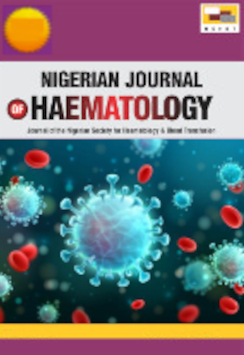HIV And Human Parvovirus B19 Co-Infection: Seroprevalence Of Serum IgM And IgM Specific Antibody And Association With C D4+ T Lymphocytes Subsets
DOI:
https://doi.org/10.60787/njhaem-7-1-2-67Keywords:
CD4+ T-cell count, Human PV-B19 IgM/IgG, HAART naïve, HIV InfectionAbstract
Background: Parvovirus B19 (PV-B19) is a global and common infection in the general population, it is more frequently associated with immunosuppression including HIV infection. It causes anaemia in HIV infections, fifth disease, arthritis and arthralgia. Thus, we hypothesize the seroprevalence of PV-B19 is higher in HIV-positive individuals than those that are HIV-negative. The objective of this study was to determine and compare the prevalence of PV-B19 specific antibodies with the level of immunosuppression between the HIV positive and negative individuals in our locality.
Materials and Methods: A cross-sectional comparative study of consecutively enrolled, 92 HIV infected, treatment naive adults and 92 HIV-uninfected controls. Their sera were analysed for PV-B19 antibodies using recombinant PV-B19 specific IgM and IgG ELISA kit, while CD4+T-cells was evaluated using Partec flow cytometer. The seroprevalence and CD4+ T cell counts of the HIV positive was compare with the HIV negative using Chi square test and Odds ratio. All statistical analysis was performed with SPSS software version 20 and a p-value of ≤ 0.05 was considered significant.
Results: The prevalence of PV-B19 IgM and IgG antibodies in HIV positive group were 28.8% (26 of 92) and 52.2% (48 of 92), respectively and those in the control group were 15.2% (14 of 92) and 32.6% (30 of 92) respectively, both were statistically significant p < 0.05. The CD4+ T-cell count of the controls was significantly (P < 0.001) higher than that of the HIV positive group, however, this was not significantly (p=0.726) associated with PV-B19 IgM and IgG antibodies.
Conclusion: Human PV-B19 infection is common among treatment naïve HIV-infected adults however this may not be completely attributed to immunosuppression. Further studies are required to elucidate the mechanisms and significance of HAART, HIV viral load and PV- B19 DNA persistence, independently of the CD4+ cell status.
Downloads
References
Cossart Y E, Tsou C, Parker R A, Chorba T L, Wulff H, Tattersall P. Detection of antibodies and antigens of human parvovirus B19. J. Clin. Microbiol. 1974;24:522–526.
Pattison JR, Jones SE, Hodgson J, Davis LR, White JM, Stroud CE, Murtaza L. Parvovirus infections and hypoplastic crisis in sickle-cell anaemia. Lancet. 1981 Mar 21;1(8221):664-5.
Pedranti MS, Barbero P, Wolff C, Ghietto LM, Zapata M et al. Infection and immunity for human parvovirus B19 in patients with febrile exanthema. Epidemiol Infect. 2012;140:454–461.
Bowman CA, Cohen BJ, Norfolk DR, Lacey CJ. Red cell aplasia associated with human parvovirus B19 and HIV infection: failure to respond clinically to intravenous. AIDS. 1990;4(10):1038-9.
Deiss V, Tratschin JD, Weitz M, Siegl G. Cloning of the human parvovirus B19 genome and structural analysis of its palindromic termini. Virology. 1990;175(1):247-54.
Mitchell SA, Welch JM, Weston-Smith S, Nicholson F, Bradbeer CS. Parvovirus infection and anaemia in a patient with AIDS: case report. Genitourin Med. 1990;66(2):95-6.
Luo W, Astell CR. A novel protein encoded by small RNAs of parvovirus B19. Virology. 1993;195(2):448-55.
Kaplan C, Morinet F, Cartron J. Virus-induced autoimmune thrombocytopenia and neutropenia. Semin Hematol. 1992;29(1):34-44.
WHO. Global summary of the AIDS Epidemic December (2015). also available at URL//www.unaids.org/epi/2015.
Schwarz TF, Gürtler LG, Zoulek G, Deinhardt F, Roggendorf M. Seroprevalence of human parvovirus B19 infection in Sao Tomé and Principe, Malawi and Mascarene Islands. Zentralbl Bakteriol. 1989;271(2):231-6.
Poovorawan Y, Theamboonlers A, Suandork P, Hirsch P. Prevalence of antibodies to parvovirus B 19 in Thailand. Southeast Asian J Trop Med Public Health. 2000;31(2):422-4.
Suandork IN, Buleke MM. The prevalence of antibodies to human parvovirus B19 in Thailand. J Med Microbiol. 2000;25:151-3.
Musa SAU, Banwat EB, Zhakom P, Rumji EM, Yakubu RK, Rufai OA. Risk of Transfusion-Transmitted Human Parvovirus B19 Infection in Anyigba and Lokoja, Kogi State – Nigeria. Iosr J Pharmacy. 2013;3(3):66-70
Bukar AA. Seroprevalence fo parvovirus B19 and its clinical effects among anaemic SCA patients. AJSIR 4,2,195-200.
Oladipo OO. Prevalence of parvovirus B19 infections among children in Lagos, age 1-15 years. Nig J of peadiat 2007;34:79.
Amuta EU, Akyala A, Azua AT. Parvovirus B19 infection among drug naïve and drug experienced seropositive HIV patients. Intern J of Academic Res. 2013;5(2):102-106.
Jegede A, Aminu M, Ella EE. Seroprevalence of human parvovirus b19 among patients African J of Clin Experimental Micro. 2014;15(1): 21-26
Ujo H, Mamman AI, Aliyu A, Ogunrinde GO. The seroprevalence of parvovirus antibodies among children with sickle cell anaemia in Zaria. African J of Clni Experimental. Microbiol. 2012;13(2):74-78
Cohen BJ, Courouce AM, Schwarz,TF, Okochi,K. and Kurtzman,G.H. Laboratory infection with parvovirus B19. J of Clin Pathol. 1995;41:1027– 1028.
Naides SJ, Howard EJ, Swack NS. Parvovirus B19 infection in HIV-1 patients failing intolerant to Zidovidine therapy. J of Infec Disea. 1993;168:101-5
Anand A, Gray ES, Brown T, Clewley JP, Cohen BJ. Human Parvovirus infection in pregnancy and hydrops fetalis. Engl J of Med. 1987;316:183.
Benet JAG, Beard S, Cohen BJ, Alimenti A, Cantiniaux B, Levy J. Secondary infection with parvovirus Bl9 in an HIV positive patient. Acquire immunodeficiency syndrome. 2015;7:1131-1132.
Serjeant GR, Topley JM, Mason K, Serjeant BE, Pattison J, Jones SE. Outbreak of aplastic crises in sickle cell anaemia associated with Parvovirus-like agent. Lancet. 1981;2(8247):595-7.
Lindblom A, Heyman M, Gustafsson I, Norbeck O, Kaldensjo T, Vernby A. Parvovirus B19 infection in children with acute lymphoblastic leukemia is associated with cytopenia resulting in prolonged interruptions of chemotherapy. Clin Infec Disease. 2008;46(4):528-36.
Young NS. Hematologic and hematopoietic consequences of parvovirus B19 infection. Semi Hematol, 1988;25:159.
Schneider E, Long SS, Pickering LK, Prober CG. Human Parvoviruses. In: Principle and Practice of Paediatric Infectious Disease. 4th edn. Philadelphia, PA: Churchill Livingstone Elsevier. 2012. 1087-1091.
Heegaard ED, Brown KE. Human parvovirus B19. Clin Microbiol Rev. 2002;15:485-505.
Kerr JR, Barah F, Mattey D. Circulating tumor necrosis factor-alpha and interferon gamma are detectable during acute and convalescent parvovirusB19 infection. Engl J of Med. 1995;321:51-60.
Nigro G, Bastianon V, Colloridi V, Ventriglia F, Gallo P. Human Parvovirus B19 infection in infancy associated with acute and chronic 93 lymphocytic myocarditis and high cytokine levels: Report of 3 cases and review. Clin of Infect Dis. 2000;31:65-69
Frickhofen N, Abkowitz J, Safford M. Persistent BI9 parvovirus infection in patients infected with human immunodeficiency virus type 1 (HIV-I): a treatable cause of anaemia in AIDS. Ann Internal Med. 1990;113:926-32
Takahashi Y, Murai C, Shibata S, Munakata Y, Ishii T. Human parvovirus B 19 as a causative agent for rheumatoid arthritis. Proc Natl Acade Science USA. 1998;95:8227-32.
Kawano Y, Noma T, Yata J. Regulation of human IgG subclass production by cytokines. J of Immunol. 1994;153:4948-58.
Kurtzman G, Frickhofen N, Kimball J, Jenkins DW, Nienhuis AW, Young NS. Pure red-cell aplasia of 10 years’ duration due to persistent parvovirus B19 infection and its cure with immunoglobulin therapy. New Eng J of Med 1989;321:519-23.
Nacimento JP, Buckley M, Brown KE, Cohen BJ. The prevalence of antibody to human parvovirus B19 in Rio Janeiro, Brazil. Revista do Instituto de Medicina Tropical de Sao Paulo; 1990;32: 41-5.
Jamo IA. Democracy, Local Government and Infrastractural Development: A Study of Zaria Local Government in Kaduna State, Nigeria. International Journal of Education, Technology and Science. 2021;1(3):46–60.
Cohen BJ, Field AM, Gudnadottir S, Beard S, Barbara JA. Blood donor screening for parvovirus B19. J of Virol Meth 1998;30:233-238.
Matsunaga Y, Goh KT, Ubagawa E. Low prevalence of antibody to the human parvovirus B19 in Singapore. Epidemiol infec 1994;113(3):537-540.
Girei AI, Alao DE, Joseph DO. Damulak J. Haematological profile of Sickle Cell Cell Anaemia in Children with human parvovirus B19 infection in Jos, North Central Nigeria. J of Med Research. 1990;22:46-5.
Anderson A, Higgins PG, Davis LR, William JS, Jones SE, Kidd IM, Pattison JRD. Experimental parvoviral infection in humans. J of Infec Dis. 1985;152:257–265.
Yoto Y, Kudoh T, Haseyama K, Suzuki N, Oda, Chiba S. Incidence of Human Parvovirus B19 DNA Detection in Blood Donors. BJH. 2008;91(4):1017-1018.
Heegaard ED, Brown KE. Human parvovirus B19. Clinical Microbiology Review 2002;15:485-505.
Ou SH, Xie JZ, Zhang YL, Ni HY Song X. Prevalence of Parvovirus B19 Infection in Chinese Xiamen Area Blood Donors. Zhongguo Shi Yan Xue Ye Xue Za Zhi 2016;24:1572-1576.
Al-Danani D A-DH, Saudi M, Al-Shamahy H. Seroprevalence of parvovirus B19 IgG among blood donors in Aden, Yemen and Alexandria, Egypt. J Chinese Clil Med 2008;3:173-176.
Kishore J, Srivastava M, Choudhary N. Standardization of B19 IgG ELISA to study the seroepidemiology of parvovirus B19 in North Indian voluntary blood donors. Asian J of Transfusion Science 2010;4:86-90.
Amasi HO, Ayat J, Al-deen A. Seroprevalance of Human Parvovirus B19 among Blood Donor Volunteers from Sudanese Blood Bank in Khartoum State. J of ImmunoBiology 2017; 2:3 DOI: 10.4172/2476-1966.
Letaief M, Vanham G, Boukef K, Yacoub S, Muylle L. Higher prevalence of parvovirus B19 in Belgian as compared to Tunisian blood donors: differential implications for prevention of transfusional transmission. Transfusion science. 1997;18:523-530.
Johargy AK. Seroprevalence of Erythrovirus B19 IgG among Saudi blood donors in Makkah, Saudi Arabia. J of Family Community Med 2009;16:111-114.
Manaresi E, Gallinella G, Morselli Labate AM, Zucchelli P, Zaccarelli D. Seroprevalence of IgG against conformational and linear capsid antigens of parvovirus B19 in Italian blood donors. Epidemiol and infec. 2004;132:857-862.
Söderlund M, Brown KE, Meurman O, Hedman K. Prokaryotic expression of a VP1 polypeptide antigen for diagnosis by a human parvovirus B19 antibody enzyme immunoassay. J of Clin Microbiol 1992;30:305-11.
Jianming Qiu,corresponding authora,* Maria Söderlund-Venermo,b,* and Neal S. Youngc. Human Parvoviruses. Clin Microbiol Rev. 2017;30(1): 43–113.
Li Q. Peak SIV replication in resting memory CD4+ T cells depletes gut lamina propria CD4+ T cells. Nature. 2005;434:1148–1152.
Gray JL, Bender BS, Quinn TC.. Haematologic abnormalities in the acquired immune syndrome. American Journal of Medicine. 1993;77:224-8.
Kapan JD, Schulte DJ, Feigin RD, Cherry JD. Demmler-Harrison, GJ, Kaplan SL. In: Feigin & Cherry's Textbook of Pediatric Infect Disea. 1992. 6th ed. Philadelphia, PA: Saunders Elsevier; Vol 2: 1902-1920
Cotmore SF, McKie LJ. Anderson CR. Astell and P. Tattersall. Identification of the major structural and nonstructural proteins encoded by human parvovirus B19 and mapping of their genes by procaryotic expression of isolated genomic fragments. J Virol. 1986;60:548-557.
Evans JP, Rossiter MA, Kumaran TO, Marsh GW, and Mortimer PP. Human parvovirus aplasia: case due to cross infection in award. British Med J. (Clinical. Research Ed). 1984;(6418). 288:681
Koziol D, EG, Kurtzman J, Ayub NS, Young D. Nosocomial human parvovirus B19 infection: lack of transmission from a chronically infected patient to hospital staff. Infect Control Hospital. Epidemiol. 1992. 13:343–348. (Erratum, 13:511.
Miyamoto K, Ogami M, Takahashi Y, Mori T, Akimoto H, Terashita T. Outbreak of human parvovirus B19 in hospital workers. J of Hospital Infect.2000. 45:238-241
Cohen BJ, Courouce AM, Schwarz TF, Okochi,K, and Kurtzman GH. Laboratory infection with parvovirus B19. J of Clin Path.1988 41: 1027– 1028. 98
Shiraishi H, Sasaki M, Nakamura N, Yaegashi K, and Sugamura H. Laboratory infection with human parvovirus B19. J of Infec.1991 22:308–310

Published
Issue
Section
License
Copyright (c) 2024 Nigerian Journal of Haematology

This work is licensed under a Creative Commons Attribution-NonCommercial 4.0 International License.








